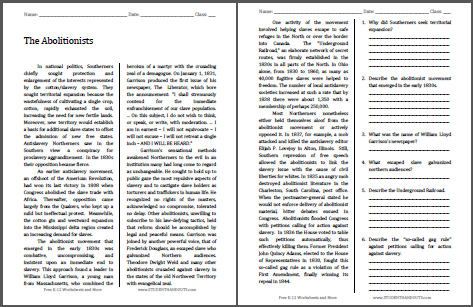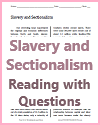The Abolitionists |
|
In national politics, Southerners chiefly sought protection
and enlargement of the interests represented by the
cotton/slavery system. They sought territorial expansion because
the wastefulness of cultivating a single crop, cotton, rapidly
exhausted the soil, increasing the need for new fertile lands.
Moreover, new territory would establish a basis for additional
slave states to offset the admission of new free states.
Antislavery Northerners saw in the Southern view a conspiracy
for proslavery aggrandizement. In the 1830s their
opposition became fierce.
The abolitionist movement that emerged in the early 1830s was
combative, uncompromising, and insistent upon an immediate end
to slavery. This approach found a leader in William Lloyd
Garrison, a young man from Massachusetts, who combined the
heroism of a martyr with the crusading zeal of a demagogue. On
January 1, 1831, Garrison produced the first issue of his
newspaper, The Liberator, which bore the
announcement: "I shall strenuously contend for the immediate
enfranchisement of our slave population. ... On this subject, I
do not wish to think, or speak, or write, with moderation. ... I
am in earnest – I will not equivocate – I will not excuse – I
will not retreat a single inch – AND I WILL BE HEARD." Garrison's sensational methods awakened Northerners to the
evil in an institution many had long come to regard as
unchangeable. He sought to hold up to public gaze the most
repulsive aspects of slavery and to castigate slave holders as
torturers and traffickers in human life. He recognized no rights
of the masters, acknowledged no compromise, tolerated no delay.
Other abolitionists, unwilling to subscribe to his law-defying
tactics, held that reform should be accomplished by legal and
peaceful means. Garrison was joined by another powerful voice,
that of Frederick Douglass, an escaped slave who galvanized
Northern audiences. Theodore Dwight Weld and many other
abolitionists crusaded against slavery in the states of the old
Northwest Territory with evangelical zeal. One activity of the movement involved helping slaves escape
to safe refuges in the North or over the border into Canada.
The "Underground Railroad," an elaborate network of secret
routes, was firmly established in the 1830s in all parts of the
North. In Ohio alone, from 1830 to 1860, as many as 40,000
fugitive slaves were helped to freedom. The number of local
antislavery societies increased at such a rate that by 1838
there were about 1,350 with a membership of perhaps 250,000. Most Northerners nonetheless either held themselves aloof from the abolitionist movement or actively opposed it. In 1837, for example, a mob attacked and killed the antislavery editor Elijah P. Lovejoy in Alton, Illinois. Still, Southern repression of free speech allowed the abolitionists to link the slavery issue with the cause of civil liberties for whites. In 1835 an angry mob destroyed abolitionist literature in the Charleston, South Carolina, post office. When the postmaster-general stated he would not enforce delivery of abolitionist material, bitter debates ensued in Congress. Abolitionists flooded Congress with petitions calling for action against slavery. In 1836 the House voted to table such petitions automatically, thus effectively killing them. Former President John Quincy Adams, elected to the House of Representatives in 1830, fought this so‑called gag rule as a violation of the First Amendment, finally winning its repeal in 1844. |
Click here to print. Answer Key: (1) Because the wastefulness of cultivating a single crop, cotton, rapidly exhausted the soil, increasing the need for new fertile lands; and new territory meant more slave states to balance out new free states. (2) combative, uncompromising, and insistent upon an immediate end to slavery. (3) The Liberator. (4) Frederick Douglass. (5) Answers will vary. (6) Answers will vary. |
 |
|---|
Text courtesy of the U.S. State Department, Bureau of International Information Programs, 2005 |


 An earlier antislavery movement, an offshoot of the American
Revolution, had won its last victory in 1808 when Congress
abolished the slave trade with Africa. Thereafter, opposition
came largely from the Quakers, who kept up a mild but
ineffectual protest. Meanwhile, the cotton gin and
westward expansion into the Mississippi delta region created an
increasing demand for slaves.
An earlier antislavery movement, an offshoot of the American
Revolution, had won its last victory in 1808 when Congress
abolished the slave trade with Africa. Thereafter, opposition
came largely from the Quakers, who kept up a mild but
ineffectual protest. Meanwhile, the cotton gin and
westward expansion into the Mississippi delta region created an
increasing demand for slaves.










